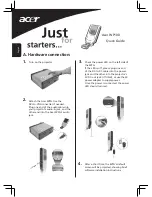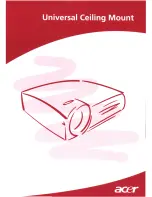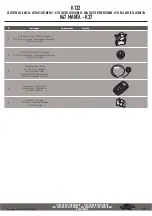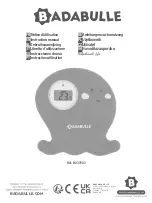
B71 ASAP B71500-E (100707)
(EN) ENGLISH
Only the techniques shown in the diagrams that are not crossed out and/or do not
display a skull and crossbones symbol are authorized. Check our Web site www.
petzl.com regularly to find the latest versions of these documents.
Contact PETZL if you have any doubt or difficulty understanding these documents.
ASAP B71
Mobile fall arrester for rope
OK TRIACT-LOCK M33 TL
Double autolocking connector
Field of application
This equipment is personal protective equipment (PPE). The ASAP mobile fall
arrester for rope is a component of a complete fall arrest system, and is designed
to arrest the fall of a single person.
The ASAP moves up or down the safety rope without manual manipulation of the
device. A rapid downward movement causes it to lock on the rope (descending too
fast, loss of control of his movements, fall).
The OK TRIACT-LOCK connector is specially designed to connect the ASAP to
the harness.
These products must not be loaded beyond their strength ratings, nor be used for
any purpose other than that for which it is designed.
WARNING
Activities involving the use of this equipment are inherently
dangerous.
You are responsible for your own actions and decisions.
Before using this equipment, you must:
- Read and understand all instructions for use.
- Get specific training in its proper use.
- Become acquainted with its capabilities and limitations.
- Understand and accept the risks involved.
Failure to heed any of these warnings may result in severe injury
or death.
Responsibility
WARNING, specific training is essential before use.
This product must only be used by competent and responsible persons, or those
placed under the direct and visual control of a competent and responsible person.
Gaining an adequate apprenticeship in appropriate techniques and methods of
protection is your own responsibility.
You personally assume all risks and responsibilities for all damage, injury or death
which may occur during or following incorrect use of our products in any manner
whatsoever. If you are not able, or not in a position to assume this responsibility or
to take this risk, do not use this equipment.
Nomenclature of parts
ASAP
(1) Frame, (2) Attachment holes, (3) Safety catch, (4) Arm, (5) Locking wheel,
(6) Protective cover, (7) Hole for ASAP / OK TRIACT-LOCK keeper cord.
OK TRIACT-LOCK
(8) Frame, (9) Gate, (10) Locking sleeve, (11) Hinge.
Principal materials: aluminum alloy (frame, arm, connector), chrome-plated steel
(locking wheel), stainless steel (safety catch), nylon (protective cover).
Inspection, points to verify
Before each use:
- Inspect the ASAP: check the condition of the body, the connection holes, the
protective cover (cracks, gouges, deformation, wear, corrosion) and the spring
of the arm. The safety catch should not rub against the frame. Rotate the locking
wheel one full turn in each direction. It should rotate smoothly and easily in both
directions. Check that the teeth on the locking wheel are clean and not worn out.
WARNING, if any teeth are missing, do not use the ASAP. If the teeth
are dirty, see the paragraph on maintenance and cleaning.
- Inspect the OK TRIACT-LOCK connector (frame, gate hinge, locking sleeve).
Open and release the gate to verify that it closes and locks properly. The Keylock
slot (gate) must not be blocked by any foreign matter (dirt, pebble, etc.).
- Inspect the rope following the manufacturer’s instructions: the rope must be
retired if it has held a fall, if the core appears damaged, if the sheath is damaged,
or if it has been in contact with chemical products that are harmful to the rope.
Finish by doing an operational check of the ASAP installed on the rope
(diagram 2).
Consult the details of the inspection procedure to be carried out for each item of
PPE on the Web at www.petzl.com/ppe or on the PETZL PPE CD-ROM.
Contact a PETZL distributor if there is any doubt about the condition of this
product.
Compatibility
Verify the compatibility of the ASAP with the other components of the fall arrest
system (compatibility = good interaction when used together).
- Safety rope:
EN 353-2: Guided type fall arresters including a flexible anchor line.
Use ASAP with EN 1891 type A semi-static ropes (core + sheath) tested during CE
certification to EN 353-2: 2002 notably:
- BEAL Antipodes 10.5 mm with a sewn termination (nylon).
- BEAL Antipodes/Industrie 11 mm with a sewn termination (nylon).
- EDELWEISS Rescue 13 mm with a sewn termination (nylon).
Other ropes are in the process of being certified: see on the Web at www.petzl.
com/ASAP
Do not use laid or twisted ropes.
EN 12841: 2006. Personal fall protection equipment. Rope access
systems. Rope adjustment devices.
- Type A = Rope adjustment device (Personal Protective Equipment).
To satisfy the requirements of EN 12841: 2006 type A, use EN 1891 type A semi-
static kernmantel ropes from 10 - 13 mm in diameter. (Note: Certification testing
was performed using BEAL Antipodes 10 mm ropes and EDELWEISS Rescue
13 mm ropes).
- Connector and energy-absorbing lanyard:
The ASAP must be used with:
- ONLY the OK TRIACT-LOCK connector for the ASAP/harness or ASAP/energy-
absorbing lanyard connection.
- ONLY the following energy-absorbing lanyards: ASAP’SORBER 20 L71 20,
ASAP’SORBER 40 L71 40 or ABSORBICA L57.
Do not extend the length of these energy-absorbing lanyards (at
most one connector at each end).
Do not use any absorber or lanyard not listed above.
- For the absorber/harness connection, verify also the compatibility of the
connectors with the fall arrest attachment points (shape, size...) of your harness.
Any equipment used with the ASAP (anchors, locking connectors, absorbers etc)
must conform to EN standards.
Contact a Petzl distributor if you are uncertain about the compatibility of your
equipment.
Diagram 1. Installation
1A. Installation on the rope
- Swing the locking wheel down by pushing down on the arm with your thumb.
- Put the rope in place, respecting the “arrow/UP” (UP) direction marked on
the body of the ASAP, and release the wheel. The “arrow/UP” marking must be
oriented up, and toward the anchor.
The ASAP is a directional device and locks in only one direction.
WARNING danger of death, do not put the ASAP on the rope upside-
down.
1B. ASAP / harness or ASAP / energy-absorbing lanyard connection
Use only the OK TRIACT-LOCK locking connector to connect the ASAP. The
connector must always be used with the gate closed and locked. Its strength is
greatly reduced if the gate is open. The carabiner is strongest when closed and
loaded on its major axis. Any other position reduces its strength. Nothing must
obstruct the connector. Any constraint or external pressure will reduce its strength.
1C. WARNING danger of death, clip the connector through the
2 attachment holes on the ASAP and make sure the rope runs
through the inside of the connector as shown in diagram 1B.
1D. Connect the system to the fall arrest attachment point of your harness.
Diagram 2. Operational check
Before each use, to verify correct installation on the rope and functioning of the
device, a test must always be carried out with the user self-belayed.
Move the ASAP up and down the rope. it must slide smoothly and easily. When
moving it down the rope, the locking wheel should turn smoothly and easily.
Test the locking on the rope by giving the ASAP a sharp tug in the direction of
a fall.
Unlock the wheel after each test.
Diagram 3. Unlocking
Unweight the ASAP then push it up the rope a few centimeters until it clicks,
keeping the wheel pressed against the rope.
Diagram 4. Removal
Remove the device from the rope as shown or reverse the installation procedure.
Energy-absorbing lanyard
If you need more mobility and/or more room between the user and the safety
rope, use a PETZL energy-absorbing lanyard (listed in the Compatibility section)
between the ASAP and your harness.
WARNING, the longer the energy-absorbing lanyard, the more significant the
potential fall height.
Diagram 5. Clearance = amount of clear free fall space
between the ASAP and an obstacle / the ground
The clearance below the user must be sufficient to prevent the user from striking
any obstacle in case of a fall.
Clearance = L (length of link between ASAP and harness) plus 1 m stopping
distance (locking of the ASAP and tearing of the energy absorber) plus 2.50 m to
account for the height of the user and the elasticity of the system.
Schéma 6. Obligations during work
- The rope between the ASAP and the anchor point must always be taut. The user
must always stay below the anchor point of the rope.
- The rope must be able to slide freely through the ASAP (e.g. be on guard against
knots in the rope, damaged sections of rope, the energy-absorbing lanyard
becoming twisted around the rope, etc.). WARNING, the device must be able to
function freely at all times. Its function must not be impeded by an obstacle or
foreign object (pebbles, mud, tree branches, keeper cord, clothing, paint, etc.).
- In certain work situations, it is obligatory to secure all tools and equipment to
prevent anything being dropped. To help avoid dropping the ASAP, use the hole (7)
to attach a keeper cord between the ASAP and the OK TRIACT-LOCK connector
(find different ways to avoid dropping equipment at www.petzl.com/ASAP).
WARNING DANGER OF DEATH, a poorly placed keeper cord can cause the ASAP to
malfunction (e.g. keeper cord jammed in the locking wheel, etc).
- Do not allow paint, cement, etc to get on your ASAP... WARNING DANGER OF
DEATH if the locking wheel becomes clogged up.
- Do not forget to tie a stopper knot in the end of the rope.
- To enable the ASAP to slide up the rope without manual manipulation, the rope
may be weighted (1 kg) or anchored below the ASAP.
- Take care to minimize the potential for falls and the height of any potential fall.
- Make sure the rope does not rub against abrasive or cutting surfaces.
Cleaning, maintenance
ASAP:
Clean the ASAP with a brush, water, and soap. Rinse with water and dry. If this
does not suffice, you can clean it with a paintbrush cleaner (solvent).
Do not immerse or submerge the ASAP in a solvent due to the risk of
damaging or clogging the mechanism.
OK TRIACT-LOCK:
Use the same cleaning method as for the ASAP. If necessary, oil the hinge and the
spring, as well as the locking sleeve.
Rope:
Wash the rope in clear, cold tap water with (optional) a cleaning product for
delicate textiles or a special detergent for rope, brushing the rope with a synthetic
brush. Follow the rope manufacturer’s cleaning instructions.
Information regarding standards
EN 12841: 2006
ASAP is an EN 12841: 2006 type A rope adjuster for preventing a fall due to the
complete failure or malfunction of the working rope (see paragraph on Clearance,
diagram 5).
Do not load the safety line when the working line is under tension.
- Shock-loading can damage the anchor line.
Nominal maximum load = 100 kg.
EN 365
Certain requirements of the EN 365 standard are explained in this notice under the
headings: Compatibility, Traceability.
Rescue plan
You must have a rescue plan and the means to rapidly implement it in case of
difficulties encountered while using this equipment. This implies an adequate
training in the necessary rescue techniques.
Anchorages: Work at height
The anchor point of the system should preferably be located above the user’s
position and must conform to the requirements of the EN 795 standard, in
particular the minimum strength of the anchor must be 10 kN.
Various
- WARNING, when using multiple pieces of equipment together, a dangerous
situation can result if the safety function of one piece of equipment is
compromised by the operation of another piece of equipment.
- Users must be medically fit for activities at height. WARNING, inert suspension in
a harness can result in serious injury or death.
- You must verify the suitability of this equipment for use in your application
with regard to applicable governmental regulations and other standards on
occupational safety.
- The instructions for use for each item of equipment used in conjunction with this
product must be respected.
- The instructions for use must be provided to users of this equipment. If the
equipment is re-sold outside the original country of destination the reseller shall
provide these instructions in the language of the country in which the product is
to be used.
Petzl general information
Lifetime
ATTENTION, in extreme cases, the lifetime of the product can be reduced to one
single use through exposure to for example any of the following: chemicals,
extreme temperatures, sharp edges, major fall or load, etc.
The
potential
lifetime of Petzl products is as follows: up to 10 years from the date
of manufacture for plastic and textile products. It is indefinite for metallic products.
The
actual
lifetime of a product ends when it meets one of the retirement criteria
listed below (see “When to retire your equipment”), or when in its system use it
is judged obsolete.
The actual lifetime is influenced by a variety of factors such as: the intensity,
frequency, and environment of use, the competence of the user, how well the
product is stored and maintained, etc.
Inspect equipment periodically for damage and/or
deterioration.
In addition to the inspection before and during use, a periodic in-depth inspection
must be carried out by a competent inspector at least once every 12 months. This
inspection must be performed at least once every 12 months. The frequency of the
in-depth inspection must be governed by the type and the intensity of use. To keep
better track of your equipment, it is preferable to assign each piece of equipment
to a unique user so that he will know its history. The results of inspections should
be documented in an “inspection record”. This document must allow recording
of the following details: type of equipment, model, name and contact information
of the manufacturer or distributor, means of identification (serial or individual
number), year of manufacture, date of purchase, date of first use, name of user,
all other pertinent information for example maintenance and frequency of use, the
history of periodic inspections (date / comments and noted problems / name and
signature of the competent person who performed the inspection / anticipated
date of next inspection). See example of detailed inspection record and other
informational tools available at www.petzl.com/ppe
When to retire your equipment
Immediately retire any equipment if:
- it fails to pass inspection (inspection before and during use and the periodic
in-depth inspection),
- it has been subjected to a major fall or load,
- you do not know its full usage history,
- it is at least 10 years old and made of plastics or textiles,
- you have any doubt as to its integrity.
Destroy retired equipment to prevent further use.
Product obsolescence
There are many reasons why a product may be judged obsolete and thus
retired before the end of its actual lifetime. Examples include: changes in
applicable standards, regulations, or legislation; development of new techniques,
incompatibility with other equipment, etc.
Modifications, repairs
Any modification, addition to, or repair of the equipment other than that authorized
by Petzl is prohibited: due to the risk of reducing the effectiveness of the
equipment.
Storage, transport
Keep your harness in a bag or other container to protect it from exposure to UV,
moisture, chemical products, etc.
Traceability and markings
You must check to ensure that the product markings remain legible during the
entire lifetime of the product.
Guarantee
This product is guaranteed for 3 years against any faults in materials or
manufacture. Exclusions from the guarantee: normal wear and tear, oxidation,
modifications or alterations, incorrect storage, poor maintenance, damage due to
accidents, to negligence, and to uses for which this product was not designed.
PETZL is not responsible for the consequences, direct, indirect or accidental, or
any other type of damage befalling or resulting from the use of its products.
Summary of Contents for ASAP B71
Page 1: ...B71 ASAP B71500 E 100707...
Page 2: ...B71 ASAP B71500 E 100707...




































